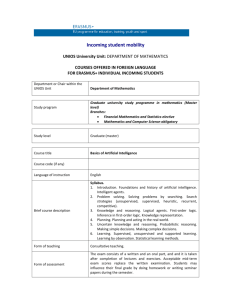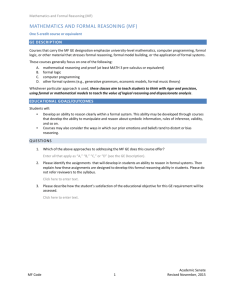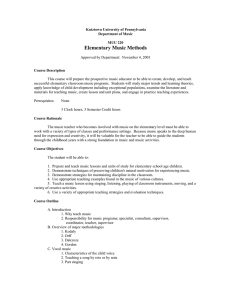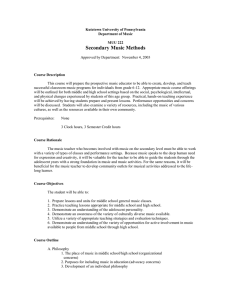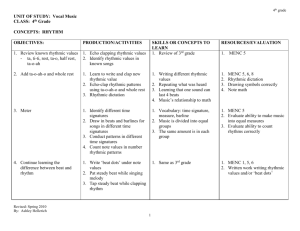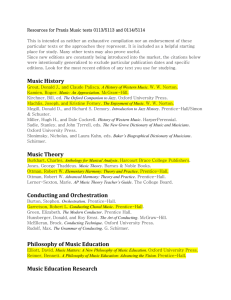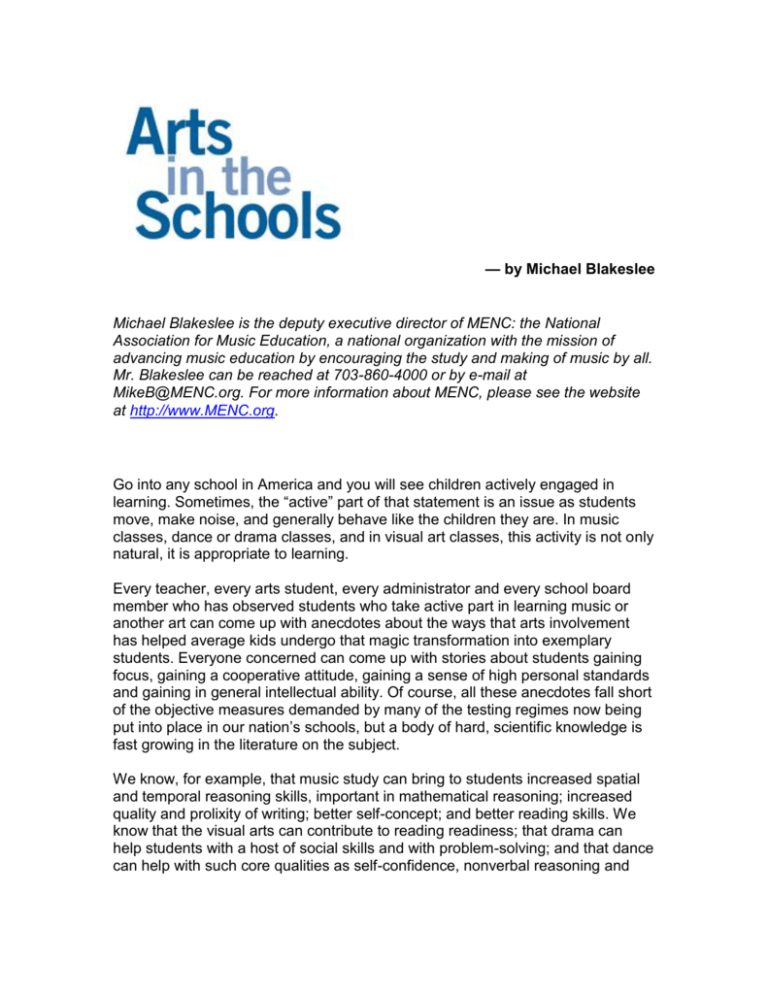
— by Michael Blakeslee
Michael Blakeslee is the deputy executive director of MENC: the National
Association for Music Education, a national organization with the mission of
advancing music education by encouraging the study and making of music by all.
Mr. Blakeslee can be reached at 703-860-4000 or by e-mail at
MikeB@MENC.org. For more information about MENC, please see the website
at http://www.MENC.org.
Go into any school in America and you will see children actively engaged in
learning. Sometimes, the “active” part of that statement is an issue as students
move, make noise, and generally behave like the children they are. In music
classes, dance or drama classes, and in visual art classes, this activity is not only
natural, it is appropriate to learning.
Every teacher, every arts student, every administrator and every school board
member who has observed students who take active part in learning music or
another art can come up with anecdotes about the ways that arts involvement
has helped average kids undergo that magic transformation into exemplary
students. Everyone concerned can come up with stories about students gaining
focus, gaining a cooperative attitude, gaining a sense of high personal standards
and gaining in general intellectual ability. Of course, all these anecdotes fall short
of the objective measures demanded by many of the testing regimes now being
put into place in our nation’s schools, but a body of hard, scientific knowledge is
fast growing in the literature on the subject.
We know, for example, that music study can bring to students increased spatial
and temporal reasoning skills, important in mathematical reasoning; increased
quality and prolixity of writing; better self-concept; and better reading skills. We
know that the visual arts can contribute to reading readiness; that drama can
help students with a host of social skills and with problem-solving; and that dance
can help with such core qualities as self-confidence, nonverbal reasoning and
persistence.1 In addition, advocates of arts in the schools can quote significant
correlations between study in music and high SAT scores, lack of disciplinary
referrals, reading acquisition and other measures of success in school.
There is even evidence that school arts programs can be a “money- and timesaving option for states looking to build skills, increase academic success,
heighten standardized test scores and lower the incidence of crime among
general and at-risk populations.”2 Why, then, are arts programs among the first
subjects to be considered for cuts as budgets get tighter?
Making the Case
Part of the answer to this question lies in the fact that the arts have rightly been
thought of as inherently valuable for so long that those most closely concerned
— artists and arts teachers — have often been slow to justify education in the
arts with reasoning that goes beyond this inherent value. Working from the value
of the arts in themselves, the argument goes that arts education is valuable
because it opens another way of understanding the world in which we live. These
arts advocates argue that developing knowledge and skill in the arts is more
likely to be carried over into a successful, rewarding life as a citizen than are
some of the specific abilities delivered in those other subjects that are more often
the focus of testing and evaluation for both students and school systems as a
whole. The process of making judgments about a song or a building’s
architecture is probably more frequent in the lives of most citizens than is the
task of solving a problem in trigonometry. (These advocates could also argue
that the economic impact of the song as a product of the music industry, or of
architecture as supplying the context in which we live and work, is highly
significant.)
And they are, in a real sense, correct: The principal reason for studying music or
the other arts — or any other subject — is really that each academic subject
presents a way of knowing and dealing with the world that is different from that
provided by other areas of study. The arts, in and of themselves, offer significant
benefits to all of us as humans. But those faced with the tough decisions of what
curricular elements can be supported as budgets get tighter sometimes need to
look at the question of how the arts in the schools will support more narrowly
defined goals.
1
The most recent and complete metastudy on the ways that arts study can help students in the
general curriculum is Critical Links: Learning in the Arts and Student Academic and Social
Development. Richard J. Deasy, editor. Washington, DC: Arts Education Partnership, 2002.
Available online at www.aep-arts.org or by calling 202.336.7016.
“The Impact of Arts Education on Workforce Preparation.” Issue Brief of the National Governor’s
Association Center for Best Practices. May 1, 2002. Page 1. Available at www.nga.org.
2
Part of the current agenda of defining goals is, of course, driven by the No Child
Left Behind Act of 2001, which raises accountability in education to a higher level
than ever before. A look at the basic requirements of the act regarding planning
by state and local education agencies reveals four aspects that are of importance
to arts education:
1. They must include accountability for student achievement.
2. They must be designed to increase student achievement in "core academic
areas."
3. They must help student achievement as measured by "challenging state
standards."
4. They must be designed to make use of "scientifically based research.”
In one way, this should not be a problem for arts educators. After all, arts
educators have led the field in authentic assessment measures as they evaluate
live or taped performances of students or assess student portfolios. The act itself
rightly defines the arts as among the “core academic subjects.”3 National
standards for arts education have been in place since 1994 and have since
influenced the development of standards in almost all the states. And though
much more research has been done on areas such as reading or mathematics
education, there is a growing amount of respectable research in the arts,
particularly in music.
The problem lies in the fact that the testing mandated by the law is specifically in
reading, in math, and (implemented somewhat later) in science. This preference
for three subjects is reflected in the U.S. Department of Education's strategic plan
at the national level, and is likely to create real anguish among school boards
and administrators as they teach toward whatever tests states adopt. The fear is
that states will scramble to put into place tests that may or may not be effective;
localities will follow up with curricula that may or may not be effective, but stand a
good chance in some cases of being narrow to the point of effectively excluding
the arts.
Justifying Resources
This is where a better understanding of the ways that music and the other arts
contribute to the world of the student becomes key. A close look at those
contributions leads to the conclusion that “programs incorporating the arts have
proven to be educational, developmentally rich, and cost-effective ways to
provide students with the skills that they need to be productive participants in
today’s economy.”4 And the benefits accrue not only to society as a whole but
most especially to the society of the school.
3
Title IX, part A. Section 9101, of the law says that "The term 'core academic subjects' means
English, reading or language arts, mathematics, science, foreign languages, civics and
government, economics, arts, history, and geography."
4
“The Impact of Arts Education on Workforce Preparation,” page 2.
Just how does this work? Once again, we have some key research results that
are especially interesting because of the way that they mirror the beliefs of
generations of those involved in arts education.5 For example:
It is a truism among those involved in music that the discipline and
cooperation required of those who play in an ensemble help in the
development of general discipline of character — and the Texas Commission
on Drug and Alcohol Abuse found in 1998 that secondary students who
participated in band or orchestra reported the lowest lifetime and current use
of tobacco, alcohol and illicit drugs. Also, according to statistics compiled by
the National Data Resource Center, students who can be classified as
“disruptive” total 12.14 percent of the total school population. In contrast, only
8.08 percent of students involved in music classes meet the same criteria as
“disruptive.”
Participation in the arts gives students a way to achieve on a personal level,
often within the context of achieving as a group that is identified with the
school. The resulting mix of personal motivation and social integration into the
school community has been valued by teachers for years — think of the
observation that “85 percent on a math test is pretty good, but no student is
satisfied with hitting 85 percent of the notes in a musical performance.” The
results of this attitudinal benefit of arts study now shows up in a variety of
measures, including statistics on cognitive engagement and dropout
prevention.
Most educators have at some point noted the prevalence of high mathematics
achievement among arts students — and analysis of U.S. Department of
Education data on more than 25,000 secondary students reveals that
students who report consistent high levels of involvement in instrumental
music over the middle and high school years show “significantly higher levels
of mathematics proficiency by grade 12.”6
Educators at the primary level have for generations used music and the other
arts to help in language and reading acquisition — and a growing body of
data shows that the arts can help in reading readiness in ways that go far
beyond the mnemonic use of songs to learn the alphabet and can even help
in reading skills for ESL students.
5
Information on these and other facts is available on the web at www.menc.org.
Catterall, James S., Richard Chapleau, and John Iwanaga. “Involvement in the Arts and Human
Development: General Involvement and Intensive Involvement in Music and Theater Arts.” Los
Angeles, CA: The Imagination Project at the UCLA Graduate School of Education and
Information Studies, 1999. Data on this music/mathematics connection is among the most highly
developed set of conclusions for the field, beginning with the work by Gordon Shaw and Frances
Rauscher on the causal relationship between music study and the development of spatiotemporal reasoning, which is important in mathematics.
6
Finally, there is the fact that music keeps students engaged in school. School
principals nationwide agree that music education — especially high-quality music
education — is important for students’ educational success, according to a study
released by MENC: The National Association for Music Education, NAMM:
International Music Products Association and the American Music Conference
and conducted by Harris Interactive. The vast majority — 96 percent — of the
principals interviewed in the study agree that participating in music education
encourages and motivates students to stay in school. Fifty-five percent “strongly
agree” with this idea. Further, 89 percent of principals feel that a high-quality
music education program contributes to their school achieving higher graduation
rates. And that agreement is backed up by objective data correlating key
educational outcomes with school music programs.
So the justification for continued inclusion of the arts in the school curriculum is
really quite simple: The arts help children grow intellectually, emotionally and
socially in ways that go a long way toward ensuring our students’ achievement.
And it is not much of a stretch to infer that all of these benefits may well transfer
to the point where they even result in coveted increases in the key indicators of
math and science scores. After all, music students already score higher than
their peers in SAT math and verbal scores.
Finding Support
So there is a hard-headed reasoning based on educational outcomes that
justifies arts programs — and that is no doubt why so many schools have
maintained lively programs in music and the other arts through the years. Finally,
there is another real-world reason that programs in music or the other arts end
up staying in most school districts, even in times of tight budgets. According to a
Gallup Poll sponsored by NAMM, the International Music Products Association,
95 percent of Americans feel music is part of a well-rounded education, 93
percent feel schools should offer musical instruction as part of the regular
curriculum and 78 percent feel states should mandate music education for all
students.
These polling results exist because the public believes deeply in the value of the
arts in education. And among the groups that value the focused activity and real
skill and knowledge-building that the arts bring to students — students, teachers
and administrators — is another group that is essential to the making of each
community’s educational policy. That group is, of course, the parents. Every time
a parent hears his or her child play in a school ensemble, that parent is drawn
closer to the world of the school and of the child’s academic success.
Used with permission from “Updating School Board Policies,” August 2002.
Copyright, 2002. National School Boards Association. All rights reserved.





